Home gym equipment doesn’t need to take up your entire floor plan. While the best exercise bikes can help manage weight, increase endurance, and build stronger hearts, they can often have cumbersome screens and footprints that take up large chunks of permanent space in your home. (1)(2) Thankfully, there are a number of relatively compact (and affordable) exercise bikes that can wedge into even the most cramped homes and gyms.
Our picks for the best exercise bikes for small spaces include options with compact dimensions, folding capabilities, and tablet-sized screens so you can get your sweat on without feeling cramped. We worked to consider a multitude of spaces, as well as users of varying fitness levels, when putting together this list, and we’re confident that there’s a choice below to fit your needs (and that itty-bitty space you have right behind your couch). Here are our top picks.
The 7 Best Exercise Bikes for Small Spaces of 2025
- Best Exercise Bike for Small Spaces Overall: ProForm Studio Bike Pro
- Best Recumbent Exercise Bike for Small Spaces: NordicTrack Commercial R35
- Best Spin Bike for Small Spaces: Schwinn IC4
- Best Budget Exercise Bike for Small Spaces: Yosuda Indoor Cycling Bike
- Best Folding Exercise Bike for Small Spaces: Marcy Foldable Upright Exercise Bike
- Best Under-Desk Exercise Bike for Small Spaces: DeskCycle 2
- Best Compact Exercise Bike for Small Spaces: Sharper Image Space Saving Stationary Bike
How We Tested and Chose the Best Exercise Bikes for Small Spaces
Our team here at BarBend consists of former D1 athletes, road bikers, CrossFit coaches, and lovers of all things cardio. We’ve pumped the pedals on over 30 exercise bikes to bring you our honest take on how the best cardio machines compare. To present a clear understanding of our testing methodology, we’ve scored categories such as durability, footprint, portability, adjustability, and more on a scale from 1 (not good) to 5 (very good). Below, you’ll find some areas we zeroed in on when selecting the best in show.
Footprint
When space is the problem, bikes with smaller footprints can be the solution. “For people who don’t have the space for regular home gym equipment but still want to exercise at home, compact items provide a solution,” notes BarBend’s expert reviewer, Amanda Capritto, CPT, CF-L1, CES, CSNC.
The average footprint of an exercise bike is 8 square feet, so we worked to include options below that average — going as small as 1.24 and 1.7 square feet. We included a few bikes of average size on our list as well, as we felt they delivered features typically found in much larger machines, like touchscreen displays and app integration.
Durability and Stability
Smaller bikes, folding bikes, and mini bikes provide more compact rides, but often at the cost of durability. However, we made it our mission to find fun-sized bikes that still sport steel or alloy steel frames that can stand up to routine use. “Durability is an important factor, because if you’re investing in a piece of exercise equipment, you want it to last for years, if not a lifetime,” mentions Capritto.
We’re big fans of the benefits of cycling, but there’s nothing worse than taking off on your ride, hoping to reap the rewards of your cardio workout, only to be distracted by a shaky screen or unstable base. We dialed in on stability during our testing, taking note of any shake, wobble, or wiggle while we rode both in and out of the saddle.
Portability
If you’re not able to carve out a dedicated spot for an exercise, you’re going to want a unit you can carry or roll without too much of a struggle. With this in mind, we looked for high-quality models with transport wheels so you can get your ride in and then move it out of the way. Additionally, we provided some lightweight folding exercise bikes that make packing up and stowing your gear in a closet or trunk a possibility.
Best Exercise Bike for Small Spaces Overall: ProForm Studio Bike Pro
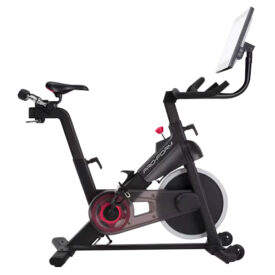
The ProForm Studio Bike Pro is a high-tech, high-quality indoor bike. It has a 10” HD touchscreen display that swivels 180 degrees to accommodate workouts both on and off the bike. It comes with three year free subscription to iFit and features silent magnetic resistance making it a great option of in-home use.
Specs
- Price: $1,404
- Dimensions: 52” H x 56.5” L x 21.9” W
- Weight: 140lbs
- Resistance: 22 levels of digital resistance
- Weight Capacity: 250lbs
Pros
- For its compact size, this bike still includes 22 levels of resistance, a 10-inch touchscreen, and iFIT app integration.
- Your purchase includes a 3-year iFIT subscription, giving you access to over 17,000 interactive and trainer-led classes.
- It has built-in transport wheels to ease the burden of moving it from room to room.
Cons
- The 250-pound user weight capacity is lower than the 300-pound standard for other bikes at this price point.
- The 10-inch display, though compact, may be too small for some riders — especially since comparable bikes can have 16- to 22-inch displays.
- It lacks a heart rate monitor or pulse sensors.
The ProForm Studio Bike Pro is our top pick for the best exercise bike for small spaces due to its trim footprint, commercial-grade steel frame, and the 3-year subscription to iFIT that comes with your purchase. iFIT is accessible on the swiveling 10-inch touchscreen, which is roughly the size of a tablet. Footprint, setup, adjustability, tech capabilities, conveniences, and value all scored a 4 out of 5.
[Related: The 8 Best Exercise Bikes with Screens]
With a length of 56.5 inches and a width of 21.9 inches, the Studio Bike Pro takes up a modest 8.59 square feet. Compared to the Peloton Bike, for example, the Studio Bike Pro is 3.5 inches shorter in length and 7 inches shorter in height. “While the 10-inch screen is smaller than what you’d see on a Peloton Bike, it made tipping the bike onto its transport wheels and moving it around easier,” noted our tester, a certified personal trainer, who gave footprint and portability a 4 out of 5.
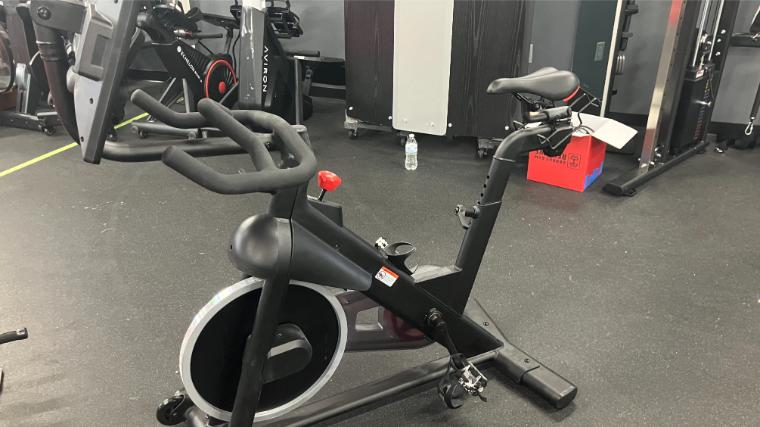
With the purchase of this bike, users get a 3-year iFIT subscription. iFIT gives you access to a vast library of cardio classes, and the bike’s swiveling display also allows you to take its strength and mobility classes off the bike. We scored it a 4.5 out of 5 for dynamic programming.
We also like iFIT’s SmartAdjust feature, which can automatically adjust your resistance to the specifications of certain classes. “iFIT is awesome,” they said. “I took a ride through Hawaii and it was super cool (and a little surprising) to feel the resistance change as I crested hills and cruised down them.” These tech capabilities scored a 4 out of 5. However, we do wish the bike had a heart rate monitor or set of pulse sensors built into it.
The lowest score this bike garnered was a 2.75 out of 5 for durability. The 250-pound user weight limit is below the 300-pound standard for comparable bikes. “The stabilizer feet helped me level out the bike, but I still experienced some mild shaking when I rode in and out of the saddle,” noted our tester. “And when I pulled on the handlebars, they’d move a little from side to side.”
Read our full ProForm Studio Bike Pro 22 Review.
Best Recumbent Exercise Bike for Small Spaces: NordicTrack Commercial R35
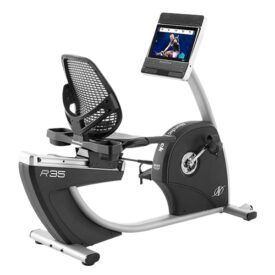
This recumbent bike features a 25-pound flywheel and 26 levels of magnetic resistance. With your purchase, you'll receive a 30-day trial to iFit, granting you access to over 16,000 workout classes ranging from cardio to strength training.
Specs
- Price: $1,499
- Dimensions: 53.42’’ H x 69.22’’ L x 23.69’’ W
- Weight: 192lbs
- Resistance: 26 levels of Silent Magnetic Resistance
- Weight Capacity: 350lbs
Pros
- This recumbent bike’s reclined seating position and backrest works to take pressure off of your back and hips.
- The 14-inch HD touchscreen is integrated with iFIT so users can stream over 17,000 classes for cycling, strength training, yoga, and more.
- The 350-pound user weight capacity is 50 pounds higher than the 300-pound average.
Cons
- After a 30-day free iFIT trial, membership will cost $39.99 a month.
- At 192 pounds and without a handle, moving this bike around can be a pain.
- The screen is only meant to watch iFIT content, so you won’t be able to stream other programming.
Sit back, relax, and take a ride on the NordicTrack Commercial R35, our pick for the best recumbent bike for small spaces. Stationary bikes are low impact by design, but recumbent bikes emphasize comfort that much more by including a backrest. The Commercial R35 provides 26 levels of Silent Magnetic Resistance, a touchscreen to stream programming, and a sturdy frame that can support users up to 350 pounds. Setup, durability, customizations, adjustability, and tech capabilities all scored a 4 out of 5.
The low profile of recumbent bikes makes them great home gym additions for seniors, those recovering from injury, or individuals with mobility issues.“Recumbent bikes allow people with mobility limitations or injuries to enjoy cycling, as they are reclined and take pressure off of the hips and back,” says BarBend expert reviewer Amanda Capritto, CPT, CF-L1, CES, CSNC.
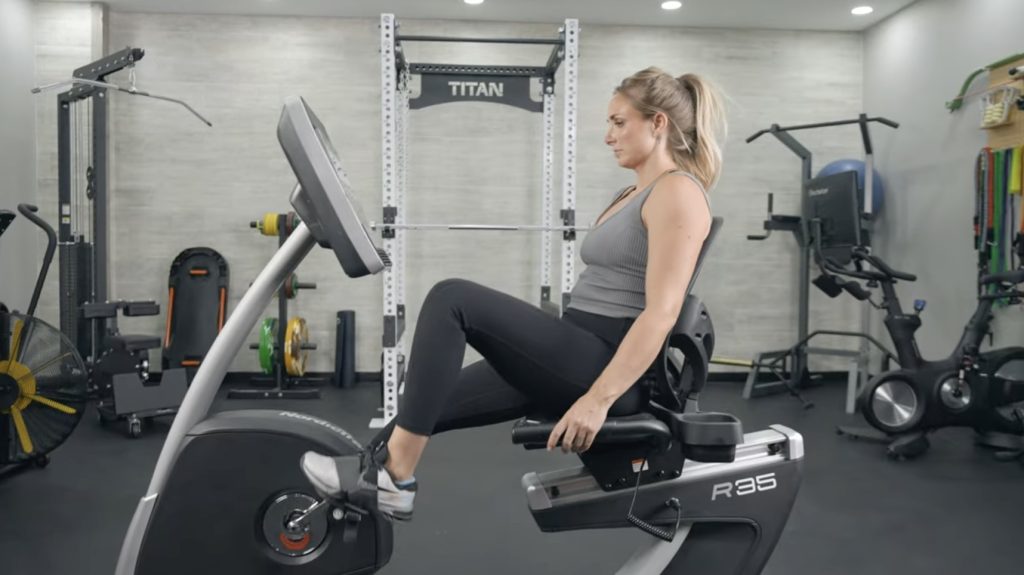
We felt secure and comfortable in the oversized seat and were impressed by the 350-pound user weight capacity, which is 50 pounds more than the 300-pound average for comparable bikes. “There wasn’t any shake or wobble when I took this bike for a ride, and due to the heightened weight capacity, I think this would be a worthwhile consideration for heavier people,” noted our tester, a certified personal trainer, who gave durability a 4 out of 5.
The 14-inch HD touchscreen can play iFIT programming, which provides over 17,000 classes from boutique-like studio rides to scenic cruises. You can also hop off the bike to take strength training, yoga, or even cooking classes. This dynamic programming scored a 5 out of 5.
However, an iFIT subscription costs $39 a month after a one-month free trial. “You can use this bike without an iFIT subscription, but you’ll only be able to cycle in a basic manual mode,” says our tester. The screen is limited to iFIT programming, so you won’t be able to stream tv shows or other fitness programming here. Tech capabilities scored a 4 out of 5.
The Commercial R35 weighs in at 192 pounds, which our tester has some issues moving around. “There are transport wheels, but since there isn’t a handle to grab onto, tipping this thing up to move was a struggle,” they noted, “While this isn’t the largest recumbent bike on the market, I’d recommend having a dedicated spot in your home for this bike.” Portability scored a 3.75 out of 5.
Read our full NordicTrack Commercial R35 Exercise Bike Review.
Best Spin Bike for Small Spaces: Schwinn IC4
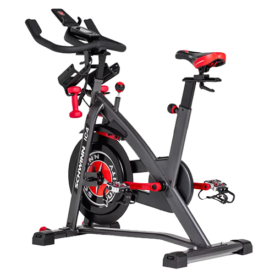
The Schwinn IC4 combines upper and lower body work with its included set of dumbbells and 100 levels of cycling resistance for a complete upper and lower body burn. Dial up your favorite streaming app and hop on, this bike is compatible with JRNY, Peloton, and Zwift.
Specs
- Price: $999
- Dimensions: 51.8’’ H x 54.6’’ L x 30.7’’ W
- Weight: 112lbs
- Resistance: 100-micro-levels of magnetic resistance
- Weight Capacity: 330lbs
Pros
- It eschews a touchscreen to save space but includes a device holder so you can stream spin classes from the app of your choice with your smartphone or tablet.
- It comes with a set of 3-pound dumbbells — and easy-reach cradles — to better replicate the studio class experience.
- The hybrid pedals allow you to either clip in with SPD cleats or slip your sneakers into toe cages.
Cons
- While there is a small LCD screen that provides training metrics, users will need to have a smartphone, tablet, or TV to stream content or classes.
- While this bike can pair with some third-party apps, the connectivity is limited so you won’t be able to track all of your ride details.
Spin classes have taken the world by storm over the last decade, but not everyone loves being stuffed like sardines inside a studio. The Schwinn IC4 is our choice for the best spin bike for small spaces due to its app compatibility, 100 levels of quiet magnetic resistance, and included set of 3-pound dumbbells. Durability, customizations, conveniences, and adjustability scored a 5 out of 5.
The IC4 eschews a touchscreen for a more compact profile, instead providing an LCD monitor that provides basic training metrics and can be used to digitally adjust and view your resistance.
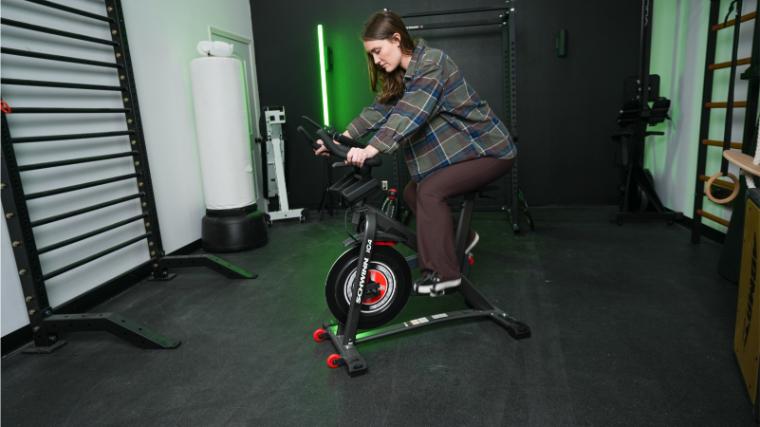
The bike does, however, include a media shelf over the handlebars and Bluetooth connectivity so you can set up your smartphone or tablet to stream spin classes from Peloton, iFIT, and Zwift. You can also connect to the included heart rate monitor for more accurate stats.
[Related: The 8 Best Fitness Apps]
JRNY is this bike’s official programming, and it offers thousands of classes for cycling, strength training, yoga, and cardio. The app’s adaptive training learns as you get stronger and recommends home workouts suited to your growing abilities.
It costs just $11.99 a month, which is a deal compared to Peloton ($44 a month) or iFIT ($39 a month). That said, our tester found that “the quality and quantity of classes aren’t as good as what you’d find on Peloton.”
Tech capabilities scored a 4 out of 5. However, some apps won’t pull all of your ride details from the bike, as detailed in the below chart.
| Speed | Power | RPM | Distance | Heart Rate | iOS or Android | |
| Peloton | No | No | Yes | No | No | iOS |
| Zwift | No | Yes | Yes | No | Yes, with a compatible HR monitor | Both |
| Sufferfest | Yes | Yes | Yes | No | Yes, with a compatible HR monitor | iOS |
| Rouvy | Yes | Yes | Yes | Yes, but may differ from console reading | Yes, with a compatible HR monitor | Both |
This bike also comes with dual water bottle holders, four-way seat and handlebar adjustability, and hybrid pedals, which allow you to either clip in with SPD cleats or slip sneakers into the toe cages.
“For being such a small bike, it’s super sturdy and durable, and you’re getting a ton of tech features for a price under $1,000,” noted tester Kate Meier, BarBend editorial member and certified personal trainer. Value, adjustability, and conveniences all scored a 5 out of 5.
Read our full Schwinn IC4 Exercise Bike Review.
Best Budget Exercise Bike for Small Spaces: Yosuda Indoor Cycling Bike
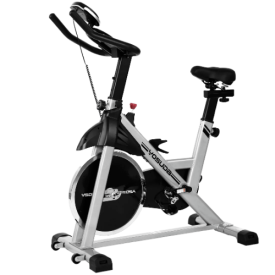
At just $233, the Yosuda YB001 Indoor Stationary Cycling Bike is the most affordable upright bike from Yosuda and with a 69-pound overall weight, most users can tilt and roll it from room to room.
Specs
- Price: $439.99
- Dimensions: 45’’ H x 40’’ L x 22’’ W
- Weight: 68lbs
- Resistance: Magnetic
- Weight Capacity: 270lbs
Pros
- This bike’s $439.99 price tag is roughly $500 to $1,500 less expensive than the average commercial bike.
- It’s about 8 inches smaller and 5 inches shorter than the average exercise bike we’ve tested, making it great for small spaces.
- The built-in tablet holder allows users to stream entertainment and classes from their own devices.
Cons
- This bike has limited tech capabilities besides a basic LCD screen.
- Our tester noticed the bike seat falling apart after repeated use.
- Some customers have complained about the bike’s durability, including an issue with the pedals falling off.
Mama loves a budget-friendly deal, and some of the best budget home gym equipment can provide users with training capabilities every bit as effective as what you’ll find on premium options. The Yosuda Indoor Cycling Bike is our choice for best budget exercise bike for small spaces due to its $439.99 price, which is a steal compared to the $1,000 to $2,000 average of many commercial bikes. Footprint, portability, and setup all scored a 4 out of 5.
Riders can save on cash and floor space with this upright cycle. Its modest footprint takes up 6.11 square feet, making it about 2 square feet smaller than the Peloton Bike. “This bike is nice and compact, so moving it around on the included transport wheels was easy for me,” noted our tester, a certified personal trainer, who gave footprint and portability a 4 out of 5.
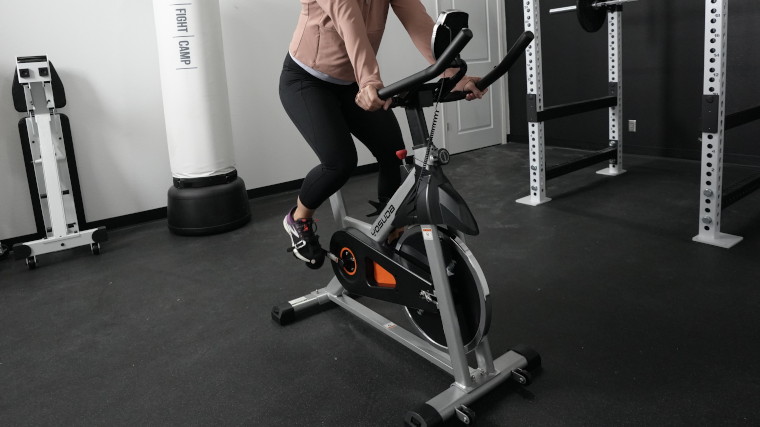
While being a budget buy, this bike includes some conveniences we’ve seen on pricier indoor cycles. For example, the seat is adjustable four ways — up, down, backwards, and forwards — and the handlebars can be adjusted up and down. “You don’t often see this much adjustability on a bike at this price point,” noted our tester. These adjustments allow for riders with a 25- to 35-inch inseam.
We also like that it has a device holder, which makes taking classes or streaming entertainment from your phone or tablet as simple as choosing what to watch.
“You can’t argue with the price, but there are some issues with durability,” noted our tester, who saw some tears on the seat after just a few uses. Some customer reviews have echoed these concerns, noting pedals falling off while in use. Durability scored a 2.5 out of 5.
“This isn’t a bike that’ll last you forever, but it’s worth considering if you’re a beginner looking for a bike that won’t break the bank,” added our tester.
Read our full Yosuda Exercise Bike Review.
Best Folding Exercise Bike for Small Spaces: Marcy Foldable Upright Exercise Bike
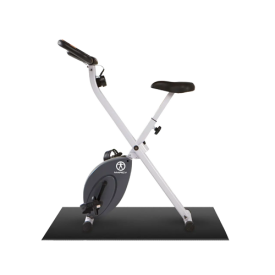
An affordable exercise bike that can fold up for easy storage. With vertical seat adjustments for an inseam between 28" and 33", the recommended height of users ranges from 5'1 to 6'3".
Specs
- Price: $189.99
- Dimensions: 42” H x 32” L x 18” W (unfolded); 51” H x 14” L x 18”W (folded)
- Weight: 37lbs
- Resistance: 8 levels of magnetic resistance
- Weight Capacity: 250lbs
Pros
- When folded, this bike shrinks from 32 inches in length to just 14 inches.
- It weighs just 37 pounds and has built-in transport wheels.
- Out of the 10 folding bikes we’ve tested, this bike’s heavy-duty 14-gauge steel frame is the most durable.
Cons
- There are only eight levels of resistance, which may not be suitable for serious cyclists and more experienced riders.
- Tech on this bike is limited to an LCD display that provides basic training metrics.
- There are no water bottle holders or a media shelf to place your phone or tablet.
There’s no better space saver in the at-home fitness game than folding bikes. After getting your HIIT or LISS cardio session in, you can fold the Marcy Foldable Upright Exercise Bike up and stow it in a closet or under the bed. When in use, it takes up about 4 square feet — making it half the size of the Peloton Bike — and when folded, it shrinks from 32 inches in length down to 14 inches. Customizations, footprint, and portability scored a 4 out of 5, with durability and warranty all getting a 5 out of 5.
“This isn’t the smallest folding exercise bike, but it’s still easy to move and can fit in small spaces,” noted our tester, a certified personal trainer. Thanks to its transport wheels and manageable weight of 37 pounds, users can roll (or hoist) this bike out of the way when not in use. Footprint and portability scored a 4 out of 5.
Folding equipment tends to be less durable than its non-folding brethren — more moving pieces can translate to more problems. We’ve tested 10 different folding exercise bikes, and the Marcy Foldable Upright Exercise Bike, which sports a 14-gauge steel frame, is easily the most sturdy and durable model we’ve tried. “I can tell they used stronger materials for this bike’s build,” noted our tester, who scored durability a 5 out of 5.
[Related: The 6 Best Folding Exercise Bikes]
All that said, we wouldn’t recommend this bike for experienced cyclists, as its resistance system provides just eight levels — well under the 16 to 32 levels you’ll find on pricier models. It’s also light on tech. “The tech on this bike is limited to an LCD screen that provides basic stats, but there isn’t a tablet stand or water bottle holder,” mentioned our tester, who scored conveniences a 2 out of 5.
Read our full Marcy Foldable Exercise Bike Review.
Best Under-Desk Exercise Bike for Small Spaces: DeskCycle 2
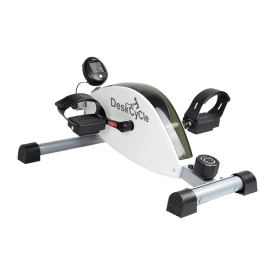
The DeskCycle Under Desk Bike was designed to help you stay active while firing off emails at work. The low-profile pedals are adjustable and compatible with desks as low as 27 inches. Its magnetic resistance, meanwhile, works to provide a whisper-quiet pedal that won't distract coworkers.
Specs
- Price: $199
- Dimensions: 10’’ H x 10.24’’ L x 24.02’’ W
- Weight: 23lbs
- Resistance: 8 levels of magnetic resistance
- Weight Capacity: 300lbs
Pros
- With a height of 10 inches, the DeskCycle 2 can easily fit under standard 30-inch tall desks.
- The eight levels of magnetic resistance are quiet, and our tester appreciated the challenge of the top two levels.
- At 23 pounds, most people will be able to move this mini bike around without too much of a struggle.
Cons
- Users taller than 5 feet 10 inches may not be able to use this device comfortably.
- The $199 price tag is on the higher end of the $20 to $250 average for mini bikes.
- While only 23 pounds, there are no handles to help with transport.
At just 10 inches tall and 24 inches wide, the DeskCycle 2 is compact enough to fit under standard 30-inch tall desks so you can get some movement in while you’re sending emails. Stability and pedal functionality scored a 5 out of 5, and resistance and durability came in right behind with a 4.5 out of 5.
[Related: The 7 Best Mini Exercise Bikes]
This bike’s pedal height adjusts from 9 to 10 inches, though those taller than 5 feet 10 inches should give it a spin before purchase to make sure it’s a good fit. Our tester, a certified personal trainer, is 5 feet 3 inches tall and they had no issues using this under her desk. “It was quiet enough that I was even able to take work calls while pedaling,” they noted, scoring adjustability and ergonomics a 4 out of 5.
Built from alloy steel, this 23-pound bike weighs more than the average 10- to 15-pound mini bike. That extra heft, though, provides additional stability. “I didn’t experience any shaking or wobbling when I pedaled,” noted our tester, who gave durability a 4.5 out of 5. We do, however, wish it included some handles to make transport easier.
“There are only eight levels of adjustable resistance, and the top two levels had my lower body working!” our tester added, noting how the bike’s bidirectional pedaling capabilities allow users to pedal either forward or backwards. The bike can also pair with Apple Watch or Fitbit trackers to help keep track of your training. Plus, the five-function LCD screen can pop off of the unit, so you can view your metrics right from your desk rather than down at your feet.
[Related: The Best Fitness Trackers for Heart Rate, Sleep Quality, and More]
At $199 — on the higher end of the $20 to $250 average for mini bikes — this unit scored a 4 out of 5 for value. “If you’re looking for something to help with rehab or to get your legs moving while stuck at a desk, this device could be super helpful,” noted our tester.
Best Compact Exercise Bike for Small Spaces: Sharper Image Space Saving Stationary Bike
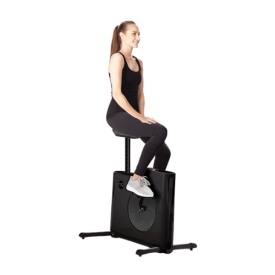
This super compact exercise bike folds up into a tiny square that you can store away under desks, under beds, or in the closet. With wheels for easy transportation, and at under 50 lbs, you can move this bike wherever you want it to go.
Specs
- Price: $349
- Dimensions: 35″ H x 27.5″ L x 22” W (unfolded); 23” H x 25.5” L x 7” W (folded)
- Weight: 39lbs
- Resistance: 8 levels of magnetic resistance
- Weight Capacity: 300lbs
Pros
- This stationary bike folds up into a compact cube that can easily stow under desks or in closets.
- No assembly is needed as this bike comes ready to go out of the box.
- The adjustable seat accommodates users between 5 feet to 6 feet 4 inches.
Cons
- There are no handlebars or a backrest to help riders balance.
- You won’t find any tech or tracking capabilities on this bike.
The Sharper Image Space Saving Stationary Bike is a unique piece of equipment, and one of the best portable exercise bikes we’ve tried. When folded, it turns into a 1.24-square-foot cube with nearly flat sides. To set it up for a ride, you pop the seat up and unfold the stabilizing legs and pedals. “When folded, this compact bike has rollaway wheels to allow for storage in small spaces,” noted our tester, a CrossFit level 1 coach. Footprint, portability, and setup scored a 5 out of 5.
“This bike is super compact, and the seat, legs, and pedals can fold into a compact cube, which is great for storage,” our tester noted, giving footprint and portability a 5 out of 5.
Due to this bike’s compact nature, setup scored a 5 out of 5. In fact, there’s no setup necessary! “Right out of the box, it was ready to go. I just had to pop out the legs and adjust the seat height and I was ready to ride,” notes our tester.
This compact design comes at the cost of handlebars or a backrest, so users who need more stability may want to look elsewhere. “I’d recommend only using this on hardwood flooring,” notes our tester. “There’s some shake when I’m riding, and I think I’d topple over if I used this on carpeting.” Durability scored a 3 out of 5.
The adjustable seat accommodates cyclists between 5 feet and 6 feet 4. However, there isn’t an LCD display or tracking capabilities on this bike. Customizations scored a 4 out of 5 and conveniences came in with a 3 out of 5. However, “there is a cup holder at the front of the bike.”
This bike is best suited for those living in small spaces who want to add some movement to their day, but can’t keep an exercise bike in a fixed location. However, we wouldn’t recommend this bike for serious cyclists, as its eight levels of resistance won’t provide more than a light challenge. And at $349 this bike is nearly double the cost of the average folding bike, but still one of the best exercise bikes under $500.
What to Consider Before Buying an Exercise Bike for Small Spaces
Since you’re here, perusing our list of the best bikes for small spaces, it’s safe to assume you have a small space and are looking for equipment that can fit. Before you pull out that credit card and hastily make a purchase, you’ll want to consider a few things, such as your available floor space and fitness level.
Footprint and Portability
I know we’re starting to sound like a broken record here, but it’s vital that you take stock of the space you have available in comparison to the product(s) you’re considering. “Triple-measure your space to make sure it will fit!” says Amanda Capritto, CPT, CF-L1, CES, CSNC.
[Related: What to Look for When Buying an Indoor Cycle]

If you see yourself having to move the bike often, look for options with transport wheels and handles to help with moving your bike between your cardio sessions. Additionally, if you’re looking for a bike that you can completely hide from sight when not in use, consider a folding exercise bike or an under-desk mini bike.
Your Fitness Goals
How hard are you looking to train? If you’ve got eyes on sweaty glory, consider exercise bikes with somewhere between 20 and 100 resistance levels for a variety in training intensity. If you’re in the market for a folding bike or mini bike, be aware that they rarely have more than eight levels of resistance, making them unsuitable for serious cyclists or those looking for more of a challenge.
If having a coach or structured workout is beneficial to your training, consider a bike with integrated programming or app compatibility. ProForm and NordicTrack bikes tend to offer iFIT integration, but this programming will often come with an added subscription fee. “These smart [bikes] are more expensive, but the immersive component can keep you motivated to exercise,” says Capritto.
Your Needs
Standard stationary bikes aren’t for everyone. If you’re someone who has physical limitations, a recumbent bike or mini bike can be more accessible. “Seniors and individuals with limited mobility may struggle to get on and off of an exercise bike, in which case a recumbent bike is recommended,” notes Capritto, who points out the step-through designs available on most recumbent bikes. Mini bikes are also a viable option, as they can be used while you’re seated in a chair or on the couch.
If you need a bike that can deliver a high-intensity training session, you’ll want to opt for an upright model, as they tend to provide larger ranges of resistance, not to mention the upright posturing that can bring your back and core in on the cardio party.
Benefits of Exercise Bikes for Small Spaces
Indoor cycling has become one of the most popular forms of exercise due to its low-impact nature and ability to improve heart health. (3) Here are some additional benefits of bringing an exercise bike into your home.
Space Saving
You’re tight on space, but you can still hit your cardio goals in these compact models. While not everyone has the room in their homes to dedicate to large pieces of machinery, exercise bikes for small spaces have compact footprints, smaller screens, and folding capabilities to save you on space.
Convenience
While many with limited space may opt to get their cycling in outside or at the gym, those who bring an exercise bike into their home are adding convenience into their lives. There’s no need to drive back and forth to the gym when you’ve got your own bike tucked away and ready to ride.
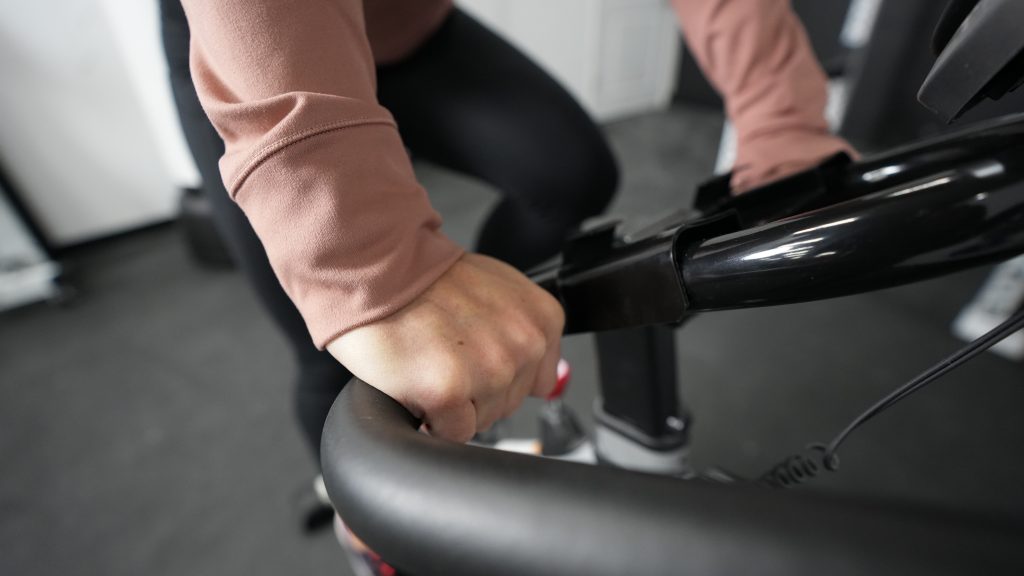
Riding a stationary bike, as compared to cycling outdoors, allows you the ability to stream content, read, or scroll through social media while you’re getting busy with your HIIT workout. There’s also the benefit of not needing to worry about an incoming storm. “Indoor exercise bikes provide access to cycling no matter the weather or outdoor conditions,” notes Amanda Capritto, CPT, CF-L1, CES, CSNC.
Low-Impact Cardio
Cardio exercise can help prevent cardiovascular disease, assist with weight management, and potentially lift your mood. (2)(4) But those with back, knee, and joint pain can find running or other high-impact forms of exercise excruciating. “There are two key groups of people I see benefitting from indoor exercise bikes the most,” notes Capritto. “People who need a low-impact way to do cardio exercise, and athletes training for an event who need a way to perform structured interval training.”
Cruising on a stationary bike is a low-impact exercise that can benefit everyone from top-level athletes to those in recovery after an injury. And if exercise bikes aren’t your jam, ellipticals and rowing machines can also provide users with low-impact cardio.
[Related: Best Rowing Machines]
How Much Do Exercise Bikes for Small Spaces Cost?
Empty out your piggy bank, because exercise bikes can cost a pretty penny. However, options for small spaces tend to be lower than the average $1,000 to $2,000 range for premium cycles.
| Best Exercise Bike for Small Spaces Overall | ProForm Studio Bike Pro | $1,404 |
| Best Recumbent Exercise Bike for Small Spaces | NordicTrack Commercial R35 | $1,499 |
| Best Spin Bike for Small Spaces | Schwinn IC4 | $999 |
| Best Budget Exercise Bike for Small Spaces | Yosuda Indoor Cycling Bike | $279 |
| Best Folding Exercise Bike for Small Spaces | Marcy Foldable Upright Exercise Bike | $189.99 |
| Best Under-Desk Exercise Bike for Small Spaces | DeskCycle2 | $199 |
| Best Compact Exercise Bike for Small Spaces | Sharper Image Space Saving Stationary Bike | $349 |
Mini bikes and folding bikes will cost less due to their lowered resistance capability, limited tech, and smaller frames, while recumbent and upright bikes tend to cost more due to the inclusion of touchscreen displays, steel builds, Bluetooth compatibility, and higher levels of resistance.
Types of Exercise Bikes for Small Spaces
We’ve got offerings of upright, recumbent, folding, and mini bikes, but only you know the type of training you’re interested in investing in. Let’s dive a little deeper into what each type of bike can provide.
Recumbent
Recumbent bikes have backrests and position the rider in a reclined position, which is great for users who need extra back support or have limited mobility. Recumbent bikes also tend to have larger and more comfortable seats than upright bikes.
[Related: Recumbent Bikes Vs. Upright Bikes — Which Is Best for Your Goals?]
These bikes are popular with older adults, and can often be found in physical therapy and rehab offices because they’re easier to get on and off of than standard upright cycles, which is perfect for individuals recovering from injury or with limited mobility.
Upright
Upright bikes are the standard exercise bike you’ve likely seen in gyms or at spin studios, where riders sit in an upright position that mimics a road bike. These bikes use either friction or magnetic resistance, and tend to have flywheels that weigh between 20 and 50 pounds. Additionally, many of these options offer programming to help with your training and, on occasion, built-in screens for streaming.
Folding
Folding bikes tend to be less durable than standard stationary bikes. They also rarely provide more than eight levels of resistance, which isn’t likely to provide much of a challenge for seasoned cyclists. While tech and conveniences are limited on these bikes, they do tend to be less expensive, ranging from around $150 to $300.
[Related: The 8 Best Exercise Bikes with Screens]
Mini
Mini bikes, or under-desk bikes, can be used while seated, and are great tools for helping users stay active during the workday or while they’re vibing out on the couch at the end of a long day. These bikes don’t have handlebars, a seat, or impressive tech, but they’ll cost around $20 to $250, making them a budget buy for those looking to move their legs.
Final Word
Bringing cardio into your routine is an exciting and worthwhile investment, but we know navigating the fitness market can be stressful. There are so many bikes, and so many types of bikes, that nailing down the perfect fit takes time, research, and maybe even a little luck. Hopefully, our roundup has given you a better understanding of the options that could potentially fit your space, whether it’s an upright, recumbent, folding, or mini bike.
Whether you’re recovering from an injury, are looking to add some movement into your workday, or are an all-star athlete looking to increase your endurance, there’s an exercise bike for small spaces that can help you get wherever you’re trying to go.
FAQs
What is the best exercise bike for small spaces?
The ProForm Studio Bike Pro is our choice for the best exercise bike for small spaces. It measures around 8 square feet, and includes a 10-inch touchscreen for streaming cardio classes via the iFIT app. The screen, which is about the size of a tablet, may be small, but it makes moving the bike around much easier than other connected models, which often have bulky 16- to 22-inch touchscreens.
Do mini bikes really work for small spaces?
You bet. They’re tiny and lightweight, and can often be tucked under desks or couches. However, while these devices are great for small spaces, seasoned cyclists may find the limited resistance not enough of a challenge for their workout.
Where should I put my exercise bike in my small space?
The furniture shuffle can be annoying, but here are some ideas of where you could fit your exercise bike: behind a couch, in place of a chair in the living room, or at the foot of your bed.
References
- Hellsten, Y., & Nyberg, M. (2015). Cardiovascular Adaptations to Exercise Training. Comprehensive Physiology, 6(1), 1–32. https://doi.org/10.1002/cphy.c140080
- Swift, D. L., Johannsen, N. M., Lavie, C. J., Earnest, C. P., & Church, T. S. (2014). The role of exercise and physical activity in weight loss and maintenance. Progress in cardiovascular diseases, 56(4), 441–447. https://doi.org/10.1016/j.pcad.2013.09.012
- Chavarrias, M., Carlos-Vivas, J., Collado-Mateo, D., & Pérez-Gómez, J. (2019). Health Benefits of Indoor Cycling: A Systematic Review. Medicina (Kaunas, Lithuania), 55(8), 452. https://doi.org/10.3390/medicina55080452
- Chavarrias, M., Carlos-Vivas, J., Collado-Mateo, D., & Pérez-Gómez, J. (2019). Health Benefits of Indoor Cycling: A Systematic Review. Medicina (Kaunas, Lithuania), 55(8), 452. https://doi.org/10.3390/medicina55080452